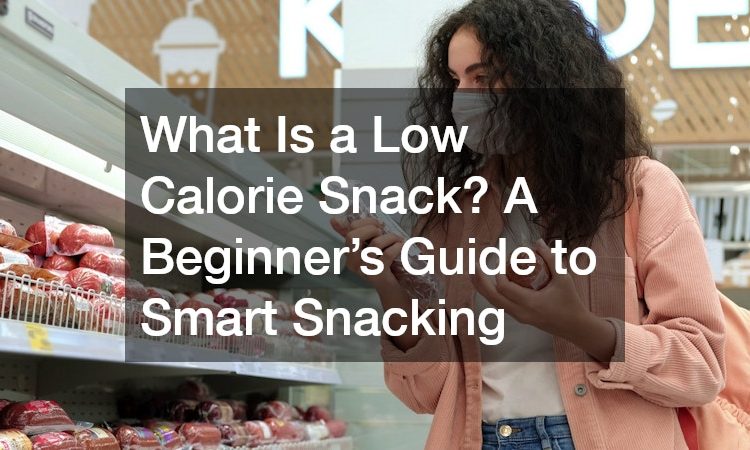
Snacking can be a delightful part of your day, providing energy, satisfaction, and a break from routine. But for health-conscious people, choosing the right snack is crucial. Eating mindlessly or indulging in calorie-dense snacks can quickly derail your health goals. This is where low calorie snacks come in, offering a smart way to curb hunger and boost nutrition without packing on extra calories.
In this beginner’s guide, we’ll explore what a low calorie snack really is, why it matters, and how you can incorporate the best low calorie snacks into your daily routine. Whether you’re trying to lose weight, maintain a balanced diet, or simply eat healthier, understanding the role of low calorie snacks will empower you to make better choices.
What Is a Low Calorie Snack and Why Should You Care?
When we talk about a low calorie snack, what does that really mean? Essentially, it’s any food item or small meal that contains relatively few calories, typically under 100 to 150 calories per serving. These snacks provide essential nutrients, satisfy hunger, and keep your energy levels stable without adding excessive calories to your daily intake.
Why is this important? Many people snack multiple times a day, and these small eating moments can significantly influence overall calorie consumption. Choosing high-calorie, low-nutrient snacks can lead to weight gain and poor nutrition. Low calorie snacks, on the other hand, help you stay on track while still enjoying tasty bites.
Benefits of low calorie snacks include:
- Better weight management
- Improved blood sugar control
- Reduced cravings for unhealthy foods
- Increased intake of vitamins, minerals, and fiber
Knowing what counts as a low calorie snack is the first step in making smarter snacking choices.
How Do You Identify a Low Calorie Snack?
Understanding what qualifies as a low calorie snack can sometimes feel confusing. Many snacks are marketed as “healthy” but hide sugars, fats, or empty calories.
Here are some practical tips to identify a true low calorie snack:
- Check the calories per serving: Aim for snacks with around 100 calories or less, especially if snacking between meals.
- Look for whole foods: Fresh fruits, vegetables, nuts in moderation, and low-fat dairy are great examples.
- Avoid processed snacks high in added sugars or saturated fats: These add calories without providing lasting energy or nutrients.
- Watch portion sizes: Even healthy foods can become high-calorie if portions are too large.
Examples of low calorie snacks include carrot sticks with hummus, a small apple, Greek yogurt with berries, or air-popped popcorn. The key is balance — you want a snack that satisfies without overloading on calories.
What Are the Best Low Calorie Snacks to Try?
If you’re wondering what the best low calorie snacks are, here’s a curated list that combines taste, nutrition, and calorie control. These snacks are easy to prepare and widely accessible:
Fresh Fruit
- Apples (1 medium = ~95 calories)
- Berries (1 cup strawberries = ~50 calories)
- Oranges (1 medium = ~60 calories)
Vegetables with Dips
- Carrot or cucumber sticks with 2 tablespoons hummus (~70-80 calories)
- Cherry tomatoes with a small sprinkle of low-fat cheese
Dairy-Based Snacks
- Greek yogurt (plain, non-fat, ½ cup = ~60 calories)
- Cottage cheese (½ cup low-fat = ~90 calories)
Nuts and Seeds (in moderation)
- 10 almonds (~70 calories)
- 1 tablespoon chia seeds (~60 calories)
Other Options
- Air-popped popcorn (3 cups = ~90 calories)
- Rice cakes with a thin spread of peanut butter (~100 calories)
- Hard-boiled egg (~70 calories)
Remember, even healthy snacks should be consumed mindfully to avoid excess calorie intake.
How Can Low Calorie Snacking Support Your Health Goals?
Incorporating low calorie snacks into your diet can support a range of health goals, including weight loss, energy management, and improved nutrient intake. Here’s how:
- Prevents overeating: Eating a low calorie snack between meals keeps hunger at bay and reduces the likelihood of overeating at mealtime.
- Maintains blood sugar levels: Balanced snacking helps avoid spikes and crashes in blood sugar, which can affect mood and energy.
- Boosts metabolism: Frequent small snacks can keep your metabolism active throughout the day.
- Increases nutrient density: Choosing nutrient-rich low calorie snacks means you get vitamins, minerals, and fiber with fewer calories.
The key is to plan your snacks ahead, keep portions in check, and choose snacks that nourish your body.
Can You Snack Smart and Still Enjoy Your Food?
Absolutely! Smart snacking doesn’t mean boring or tasteless food. With a little creativity, low calorie snacks can be both delicious and satisfying. Here are some quick tips to elevate your snacking:
- Add herbs and spices like cinnamon or chili powder to fruits or nuts for extra flavor.
- Use Greek yogurt as a base for smoothies or dips.
- Combine crunchy veggies with creamy hummus or guacamole.
- Swap chips for air-popped popcorn sprinkled with nutritional yeast or smoked paprika.
By focusing on flavor and texture, low calorie snacks can become an enjoyable part of your day, not just a “healthy chore.”
Final Thoughts
Understanding what a low calorie snack is and incorporating these options into your routine is a practical and effective way to stay healthy and energized. By choosing snacks that are low in calories but rich in nutrients, you’re making a smart investment in your long-term wellness.
Whether your goal is weight management or simply eating better, remember that balance and mindful eating are essential. Try experimenting with the best low calorie snacks listed above, and discover how enjoyable healthy snacking can be!


